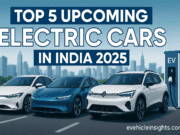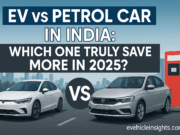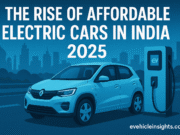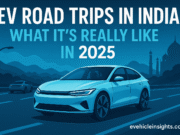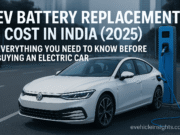TL;DR
- Yes, EVs lose range gradually.
- Most Indian EVs lose around 10–15% range in 5 years.
- Battery degradation depends on how you drive, charge, and even where you park.
- It’s not the nightmare people make it out to be — especially with today’s tech and warranties.
So… Is Range Degradation the EV Industry’s Dirty Secret?
Not exactly. It’s more like that slightly awkward relative at family gatherings — everyone knows it’s there, but no one wants to talk about it too much.
If you’ve ever typed “Do EVs lose range over time?” into Google at 1 AM, you’re not alone. It’s one of the biggest unspoken concerns for new buyers. After all, nobody wants to spend ₹15–20 lakhs on a car only to see its range shrink like cotton in a hot wash.
But here’s the thing — range degradation is real, expected, and manageable. In fact, it’s probably way less dramatic than your neighbor’s WhatsApp forward made it sound.
Let’s break it all down — honestly, practically, and with a bit of real-world perspective.
Why EV Batteries Lose Range in the First Place (No Jargon, Promise)
Imagine your EV battery like your phone battery — only way more sophisticated. Every time you charge it and drive, a little bit of chemical wear happens. Over thousands of these cycles, the battery can’t hold quite as much juice as it used to.
Think of it like a reusable water bottle that starts to get scuffed and stained the more you use it. It still works — just not quite as fresh as day one.
In EV terms? You might start with 400 km of range, and 5 years later, maybe you’re getting around 340. Not ideal, but not a disaster either.
What the Numbers Say (and What They Don’t)
Let’s get something clear: degradation isn’t a cliff. It’s more like a slope. Smooth, slow, and very gradual.
Here’s how things typically look for Indian EVs in 2025:
| Year of Ownership | Average Battery Health | Approximate Real-World Range Loss |
| Year 1 | 97–98% | Barely noticeable |
| Year 3 | 92–94% | Slight dip (you’ll feel it on long trips) |
| Year 5 | 85–90% | You’ll notice — especially in highway use |
| Year 8+ | 75–82% | Range loss becomes real, but car’s still usable |
Why faster loss in India? Simple: heat, traffic, power grid fluctuations, and fast charging in 42°C summer afternoons. Our roads — and climate — are rough on batteries.
But even so, for the average driver doing city commutes, this isn’t a dealbreaker.
Storytime: How a Real Nexon.ev Owner Noticed the Drop
Ravi, a 39-year-old architect in Pune, bought his Tata Nexon.ev back in late 2020. He used it for daily work travel and the occasional weekend outstation trip. Charged mostly at home, but fast-charged during trips.
Fast forward to 2025 — his EV still drives like new. But he admits the range has dropped.
“When I bought it, I could easily get 240–250 km in mixed use. Now, I get about 200–210. I’ve had to adjust a bit on long drives, but for city use? No complaints.”
What changed? Not much. He just avoids pushing it to 100% charge unless needed and fast charges only when on the highway. The car? Still going strong.
Common Mistakes That Kill Your Battery (Even If You Mean Well)
You might be shortening your EV’s battery life without even knowing it. Here’s what to avoid:
- Charging to 100% and letting the car sit unused for days
- Letting charge drop below 10% regularly
- Using DC fast chargers every single time
- Parking out in the sun when you have covered parking right there
- Driving aggressively with heavy AC usage in peak heat
- Ignoring battery software updates (yes, those help!)
None of these will destroy your battery overnight. But together, they’ll chip away at it faster than you’d like.
What Automakers Will (and Won’t) Tell You
Every major EV brand in India — Tata, MG, BYD, Hyundai, Kia — now offers 8-year warranties on their EV batteries.
But here’s the catch: those warranties only cover capacity drops below 70%. So if your battery goes from 100% to 72%, you’re technically still on your own.
That said, most owners won’t even hit the 75% mark before selling or upgrading. Battery failure is extremely rare. Battery fade? That’s the reality — but it’s a slow fade, not a sudden blackout.
What You Can Do to Slow It Down
You don’t need to be a battery geek. Just follow these common-sense steps:
- Try to charge between 20% and 80% for daily use
- Reserve 100% charges for road trips
- Don’t fast charge unless necessary
- Park in shade — or better, a garage
- Update your EV software regularly
- Don’t leave the car idle with a full or empty battery for days
It’s like keeping your body healthy — don’t abuse it, and it’ll last you longer.
Still Worried? Here’s Some Perspective.
Let’s say you lose 15% range over 5 years. Your Nexon.ev goes from 312 km to 265 km.
But ask yourself: how often are you actually driving more than 200 km in one stretch?
For city dwellers — and that’s most of us — this drop makes little difference. You’ll still reach work, run errands, and take weekend trips without planning like a space launch.
And remember — charging infra is growing. So by the time you do notice the dip, charging stations will be everywhere.
Final Thoughts: Stop Worrying, Start Driving
Yes, EVs lose range. Just like smartphones, just like petrol cars lose mileage over time.
But it’s not a “gotcha” moment. It’s part of the EV journey. And as long as you drive smart, charge smarter, and manage expectations, your EV will serve you well — quietly, cleanly, and without the drama of oil changes or clutch failures.
So don’t let the fear of fading range keep you from driving into the electric future.

